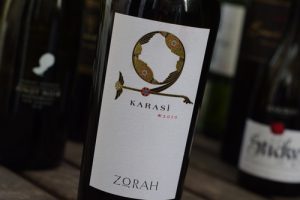For many villagers across Armenia, karases—the egg-shaped terracotta jugs used for winemaking in the region—aren’t worth the basement space they occupy. Despite the fact that in recent years, they have become a symbol of ancient civilization in the region and a testament to Armenia’s viticultural significance (giving it an edge over its friendly rival, Georgia), karases as an instrument have fallen farther and farther into a well of obscurity.
Today, the word is more likely to reference a brand than an ancient vessel. And where culture and commerce meet, there are sure to be complications—even, paradoxically, in the very industry karases exist to serve.
Karas Wines is one of Armenia’s largest contemporary wineries, launched nearly a decade ago as the wine branch of Tierras de Armenia CJSC. Tierras de Armenia was formed six years prior by Argentinian-Armenian entrepreneur Eduardo Eurnekian, as the agricultural tendril of a series of strategic investments. Eurnekian, who also owns the main postal office, a bank, and the country’s airport, saw it as a way to impact change on what he considered one of the most important sectors of Armenia’s economy.
Up to that point, the alcohol industry in Armenia had mimicked what it was in Soviet years, where Armenia had been designated as the brandy-producing arm of the U.S.S.R. Tierras de Armenia had begun its operations with that in mind, growing grapes for the purpose of making cognac. But upon witnessing the high caliber of grapes they were growing, they quickly shifted to winemaking. After all, just one great wine could transform the market.
“We started our work in Armenian winemaking when practically no good quality wines were produced in the country,” says Juliana Del Aguila, Eurnekian’s niece and Director of Karas’ Operations, “No one really knew about quality winemaking (even being the first country in the world where wine was produced more than 6,000 years ago), no one even knew what the word ‘karas’ meant!”
The romantic story about Armenia as the birthplace of wine plays a big role in Karas Wines’ marketing—as their copywriter for a brief period in 2017, I would know. It is, however, not history, but modernity that forms the key ingredient to their success. They utilize contemporary viticultural expertise and modern technology in all stages of their process, and their wines are fermented in stainless steel vats, not the old, clay karas, as their name suggests. The company’s relationship to the ancient vessel is purely an abstract one.

Karas Wines’ operations, located in Armavir, where their wines are fermented in modern, stainless steel tanks. (Photo: Karas Wines)
Del Aguila explains that the reference to was never meant to be literal. “With the name ‘Karas,’ we aimed to revive this tradition and tell about winemaking and how it started, in the land that we love and care for and that has so much story to tell to the world,” she says, “We have worked a lot under this brand and name that represents us and Armenia.”
Tierras de Armenia filed a trademark with the Intellectual Property Agency (IPA) on the word “Karas,” which was granted to them on Sept. 17, 2011, and officially registered on June 6, 2012, under the serial number 18470.
Around the same time Karas Wines was getting on its feet, another winery was operating in a similar vein, founded by Zorik Gharibian, an Armenian diasporan who had built his former success in the Italian fashion industry. Always a wine lover, Gharibian and his wife, Yeraz Thomassian, had dreamt for many years of opening their own winery. Up until that point, they had been working in Armenia through the fashion industry, bringing manufacturing to the region. But when news of the Areni-1 cave spread, they decided to pursue that dream in Armenia. Thus began Zorah Wines.
From the start, it was a small, very niche operation. And though the Gharibians spared no expense in securing modern equipment for their production, the ancient vessel, karas, also plays an important role. Gharibian says that after the Areni-1 cave discovery, he saw an opportunity to bring back wine heritage in Armenia in what he considered the most authentic way possible: through the karas. And he has gone to painstaking efforts to do so, a process which was detailed in my investigation for Smithsonian.com a year ago.
By utilizing Armenia’s clay terracotta, Gharibian was also capitalizing on a more global trend in the wine community: the comeback of amphora-made wines. And in this pursuit he has been quite successful. Zorah’s first vintage was released in 2012, named “Karasì,” or “of the karas,” referencing the fact that the wine was aged in Armenian amphorae. Within months, it had made Bloomberg’s list of top ten wines.
But Gharibian started noticing some of the peculiarities associated with bringing Armenia’s cultural heritage into the modern market place in 2011, when he attempted to filed a trademark with the IPA on the word “Karasì,” but was rejected.
“They [the IPA] rejected us because one, they said the word “Karasì” could confuse the consumer into thinking that the wines were aged in karas, and two, it was a common word,” explains Thomassian, “We went back to them saying that our wines were aged in karas and that is exactly why we were naming the wine ‘Karasì.’” Shortly afterwards, the IPA returned to them with a non-binding agreement.
Six months later, when the “Karas” trademark was given to Karas Wines (“—no questions asked!”), the Gharibians reapplied for a different trademark in Oct. 2011. This time, it included the entire text on their bottle’s label: “Զ Karasì Zorah.” On March 12, 2012, this title was registered and authorized by the IPA.
***
Confusion over the different manifestations of the word “karas” in Armenia’s tiny wine market has inevitably ensued. Speaking to Hetq.am last February, Del Aguila cited an instance in which she ordered Karas at a restaurant and was offered Zorah’s Karasi instead. She says that, even though the word “karas” is being used on his wine’s label as a way to designate the mode of production, and she worries that the branding is too confusing.
Part of the confusion may stem from the fact that the two brands do not have an equal presence in Armenia’s local market. Being far more affordable (a bottle of Karas Wines’ Dry Red runs for around $8 or $9 USD), brand awareness of Karas is as a result much higher in Armenia. For Zorah Wines, creating karas-made wines has come at a price—and that price is over $30. The Gharibians admit their Karasí was never really intended for a local market. Curiously enough, a company which does not employ the use of karas in its production [Karas Wines] has more weight to the word—simply because people can afford it.
Del Aguila says that whatever the reason, consumers and sales people are simply not differentiating the two. She cited an example when several popular supermarkets, SAS and Nor Zovq, featured incorrectly labelled the wines in their showrooms, lumping in Zorah’s products under the Karas label. Zorah’s wines “Voski,” and “Yeraz,” for example, both do not have the word “karas” on their label, but were labeled as “Karas Zorah Voski” and “Karas Zorah Yeraz.” Whether this is a result of negligence on the supermarket’s part or actual trademark infringement, however, is difficult to ascertain.
In 2017, Tierras de Armenia went so far as to hire a firm called Alpha Plus Consulting to measure the extent of the confusion. In a study conducted by the company, 28 percent of consumers thought both trademarks were owned by the same producer. And in sales, that number was even worse. Forty percent of sales people thought that the wines were owned by the same producer.
Del Aguila says she had initially hoped the two companies might settle the matter privately between them, but it wasn’t long before things got ugly. In May 2016, Karas Wines filed its first lawsuit against Zorah Wines for trademark infringement.
***
It was a bitter battle, that unfolded publicly across local and international media. Until now, Gharibian maintains that “karas” is a word which belongs to all Armenian winemakers. He and Thomassian say that, even if they had been granted the trademark on the word, they would not prohibit other companies from using it (and in fact, another winery in Armenia has recently come out with a Karasí line of their own, a fact which Gharibian lauds), and they believe Karas Wines’ actions are an effort to “monopolize” a piece of Armenia’s shared cultural heritage.
In a scathing open letter to Eurnekian, published last January, Gharibian wrote that by not sharing the word, Armenia’s future winemakers “will have to stand on international and domestic platforms and talk of Armenia’s 6,000 year winemaking history using words such as Amphorae, Qvevri or Thala and explain that our endemic word “karas” was sold to the highest bidder, a powerful corporation, for personal promotion and brand usage.”
Karas Wines recently won its second case against Zorah, delivered last February in Armenia’s Court of Appeals. But while the victory went to Karas, Del Aguila says her team has lost a lot in the process. Leading up to the verdict, Gharibian acquired a lot of grass roots support. His story is easy to get behind—especially given that Eurnekian’s team has claimed legal ownership over a word it has little practical relationship to. Even Georgians have chimed in to voice their condemnation.
Del Aguila complains that the press coverage, which tends to favor the “little guy” (in this case, Gharibian, whose production and overall entrepreneurial reach in Armenia pales in comparison to Eurnekian’s), has been slanted and unfair. “It was never in our agenda to monopolize,” she told the Weekly. “The core of this project is to create opportunities, Armenia has a lot to give and fortunately, a lot of new wineries have joined our path and are making great Armenian wines… And this is not only damaging our prestigious brand, but also the more than 500 families that are part of this amazing project.”
“Consumers should know exactly what products they are buying,” she told Hetq in a rare interview, “I believe Karasí Zorah is fantastic wine, but I also do not want it to be confused with Karas.”
Gharibian, on the other hand, says the debate will not end here. After the verdict was delivered in February, he told reporters that he plans to take the matter to Armenia’s Court of Cassation, and if all else fails, to international courts, where is convinced he would win. “I’m ready to finish this fight,” Gharibian told Hetq last December, “It’s a matter of principle for me.”
The post The Controversy Over ‘Karas’—A Term for Commerce or Cultural Heritage? appeared first on The Armenian Weekly.
Source: Armenian Weekly
Link: The Controversy Over ‘Karas’—A Term for Commerce or Cultural Heritage?





